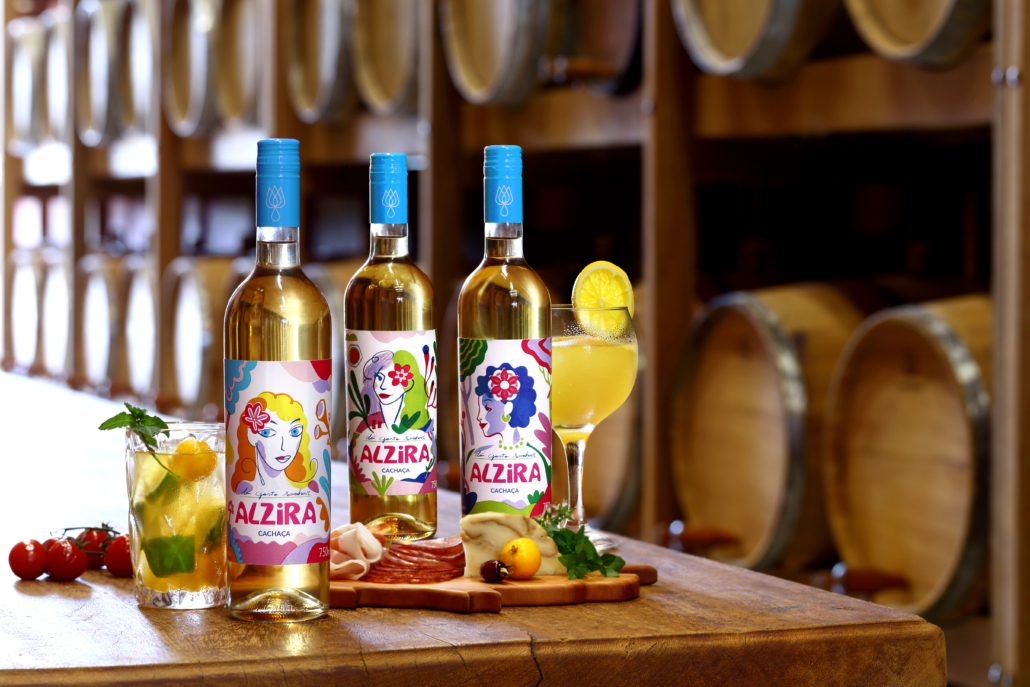Alzira’s dream: from Torrinha to the world
Article published on the website A Tribuna Piracicabana on September 21, 2021

Alzira Cachaça presents excellent sensory quality, with an intense, bright straw-yellow color
When the Portuguese arrived in Brazil and started the sugar cane cycle, with them, almost at the same time, the first alembics that would give life to cachaça, the most Brazilian of all drinks, docked here. Beloved by the Brazilian people, cachaça is the object of passion of Octaviano Della Colletta, a son of Italian immigrants, who was a fan of cachaça – his favorite drink –, and the source of inspiration for the distillery that bears his name.
Octaviano had two great passions in life. The first, Dona Alzira, and the second, the art of drinking and aging Cachaça. The love story between him and Dona Alzira, with whom he lived for 75 years, permeates the creation of a Premium cachaça named after the matriarch. A tribute to this woman who was ahead of her time. An independent and free dreamer. Thus, Alzira Cachaça was born. With a Brazilian soul, light, refreshing, and casual, produced in Torrinha, in the inland of São Paulo, and available in three labels with colorful and playful illustrations.
Alzira is the materialization of the dream of Gustavo, Octaviano’s grandson, and his wife Célia, both from the inland of the state. Although separated by only 50km between Barra Bonita and Torrinha, it took the big city, São Paulo, to bring them together and unite what they have in common – the passion for gastronomy. From the pleasure of cooking together came France and Le Cordon Bleu. From there emerged not just a couple, but a pair of Chefs whose roles alternate according to the needs of the recipe. A model of perfect partnership, a couple who shares endless curiosity and appetite, kilometers collected around the world, as well as recipes, flavors, and memories.
Members of the Académie Culinaire de France, Célia being the first woman to join the institution, they have one foot in the 15ème, in Paris, and the other in São Paulo, added to their caipira roots. Rice and beans and hautes tables (high tables), pubs, and three-star establishments. All jumbled together.
From this partnership permeated by love for food and drink came the couple’s interest in producing a caipira cachaça, made in Torrinha, to win the world over. The construction of the distillery would also be the opportunity to honor the grandfather, Octaviano Della Colletta. The refined preparation method, modern equipment, careful production techniques, and the care with every detail of the process make Alzira Cachaça unique. The architectural project and structure designed there are in no way inferior to the most emblematic international distilleries. The couple’s idea is to open the house for guided tours when the pandemic is under control, so that the public can follow the fascinating production process of the ODC Premium Cachaças.
Alzira Cachaça presents excellent sensory quality, with an intense, bright straw-yellow color. Its tears slowly run down the sides of the glass. Sweet and fruit syrup are the main aromas of this cachaça. The alcoholic aroma is smooth and balanced. The low acidity brings an increased viscous sensation and velvety notes to the palate, making Alzira Cachaça smooth and very pleasant. Perfect to drink neat, on the rocks, or in various drinks. All these characteristics result from a superior quality in its production process, and in its storage in Amburana and Jequitibá woods. Once finished, the blend is rounded off in smaller Pink Jequitibá tanks, in order to shape and balance the sensory profile obtained by mixing the woods.
Terra roxa soil cachaça
One cannot use the term terroir to talk about cachaça, but one can talk about the origin and characteristics of the soil, climate, and region. Sugar cane plantations develop well in regions of Terra roxa soil and in a predominantly hot climate, which is the case of Torrinha, a municipality where the Octaviano Della Colletta Distillery is located, at Fazenda Basalto. It is worth mentioning that the farm is a Single State property, which means that all the sugar cane used in the production of Cachaça comes from its own sugar cane plantation, without the interference of third parties.
Why Torrinha? The Terra roxa soil in this municipality contains more clay and iron, so the sugar cane is strong and has a high concentration per hectare. The sugar cane has an elevated brix content – a numerical scale that measures the amount of soluble solids, such as sugar and sucrose – which makes the juice sweeter, bringing important sensory notes and a prominent flavor to the cachaça.
Torrinha is close to 1,000 m above sea level, hence the mild climate that helps fermentation. A small temperature range between day and night makes the yeast act in a more cadenced way, reducing contaminations, but without exceeding the limit of 30 degrees. Therefore, it is easier to maintain the ideal temperature.
Fermentation is conducted using a culture of selected yeasts specific to the production of a quality cachaça, which in turn are influenced by native yeasts throughout the process. All the main aroma and flavor components are generated in this carefully conducted fermentation with strict controls of temperature, pH, acidity, brix, and alcohol content of the final product to be distilled.
From planting to the final product, the distillery is responsible for the entire production process. You plant the sugar cane, wait it to grow, and then make it go through a process of milling, filtering, and fermentation, until it reaches the copper alembics for distillation. Here the best part of the cachaça is separated, and will be aged in Brazilian wood barrels, discarding the parts that are unfit for consumption. Extreme care with quality, traceability, and laboratory techniques fitting the mold of international distilleries bring innovation to the universe of cachaça.
Sustainable production with social responsibility
In sugar cane cultivation, the distillery uses only natural inputs, and at no stage does it use chemical substances such as pesticides. The focus is on organic and biodynamic practices, without the use of agrochemicals. In addition to that, there is the eco-friendly concern for the surroundings, by adopting sustainable cultivation practices, in which the property is connected with the environment and society.
The farm is inside a legal reserve, a PPA, 15m away from the river, with bamboo bushes, citrus groves, and animals. In production, sugar cane straw bales are used to generate energy in the boiler burnings, while the sugar cane bagasse and vinasse are used to generate fertilizer, causing better disposal of micronutrients.
Electricity is generated with solar panels fixed on top of the distillery, which supplies 100% of its own energy consumption. Furthermore, most vehicles are powered by alcohol produced through the redistillation of the head and tail discarded in the cachaça production process.
Attentive to the environmental agenda, the entrepreneurs of Alzira Cachaça have been planning social responsibility actions, starting with the NGO they created, which already provides education to approximately 20 children in the region. One of the achievements includes the sponsorship of the Brazilian ballet dancer Letícia Cappa, who is in Spain at the Barcelona Dance Center. The model pursued is inspired by the foundation of sisters Robin and Andrea McBride, in their clear mission to engage wine in community actions with a strong social impact.
One of them is the She Can Wines initiative, promoted since 2019, in which they dedicate efforts to eliminate gender and race gaps in leadership positions in male-dominated fields, providing professional development scholarships to emerging female leaders. One more possible dream that Alzira aims at, before so many others to come.
Link to the original published article (same content in Portuguese)





